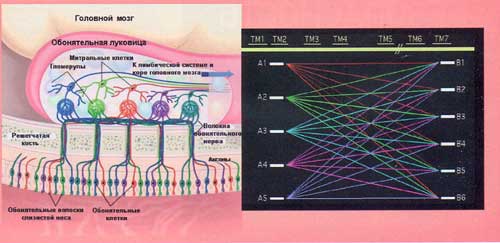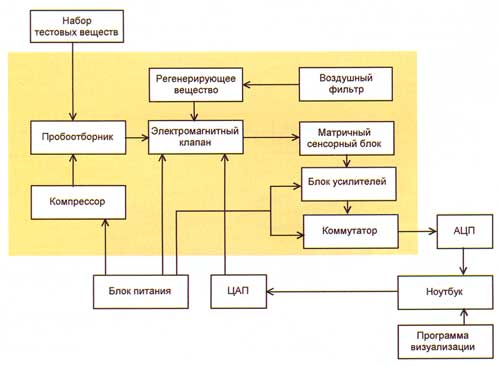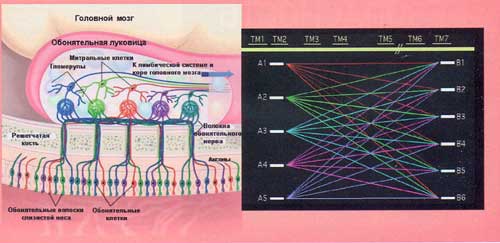
ELECTRONIC HOC — A NEW DIRECTION IN THE SECURITY INDUSTRY.
N. Dolgopolov, M. Yablokov
Peace and Security No. 4, 2007
One of the promising areas of using nanotechnology achievements in security systems is the creation of technical means such as the «Electronic Nose», designed to detect ultra-low concentrations of substances prohibited for distribution.
Attempts to understand the nature of smell have been made by mankind throughout the development of society.
However, a revolutionary breakthrough in the field of olfactory receptors and the organization of the olfactory system was made only recently.
For their outstanding research results, Richard Axel and Linda Buck received the Nobel Prize in Medicine in 2004.
They discovered about 900 genes that are associated with the same number of olfactory receptors located in the upper part of the nasal cavity and containing about 50 million primary receptor cells.
Activated cells «transmit signals» to the glomulers and then to the mitral cells of the olfactory bulb.
The signals then travel to the cerebral cortex, where information from various receptors is collected into a final “print” corresponding to a specific odor (Fig. 1).
You can learn more about the mechanism of olfactory recognition in the materials of the Nobel lectures of R. Axel and L. Bak.
Fig. 1. The mechanism of olfactory recognition
The “electronic nose” is the name given to the multisensory system for recognizing components of gas mixtures.
These include devices operating on various physical principles presented in Table 1, in particular portable ion mobility analyzers, portable gas chromatographs.
Most devices cost from $20,000 to $100,000, while a significant reduction in cost is predicted as the technology for manufacturing the sensors themselves improves.
Until now, there are practically no portable models of this product on the market.
Table 1. Classification of devices of the «Electronic nose» type
| № | Sensor type | Measuring principle | Manufacturing method | Manufacturer, cost (thousands of $) |
| 1 | Metal oxide | Conductivity | Microelectronics | Lennartz Electronics GmbH (55), Alpha MOS-Multy Organoleptic Systems (20), Nordic Sensor Technologies (40) |
| 2 | Conductive polymers | Conductivity | Technology microprinting | Alpha MOS-Multy Organoleptic Systems (20,000), Aroma scan PLC (50), Cyrano Science Inc. |
| 3 | Piezo Crystal Microbalance | Mass Increment | Microfilm Deposition Technologies | HKR Sensorsystems GmbH, Alpha MOS-Multy Organoleptic Systems (20). |
| 4 | Surface Acoustic Waves | Mass Increment | Microfilm Deposition Technologies | Savtec Inc (5), Electronic Sensor Thechnology (25) IEEV Ltd Chemical Sensor Systems |
| 5 | Catalytic transistors | Capacitance charge measurement | Microelectronic technologies | Nordic Sensor Technologies (40) |
| 6 | Optoelectronic sensors | Fluorescence, IR spectrum, microfilm analysis | Precision technologies, dye application | Nordic Sensor Technologies (60) |
Unlike traditional sensor systems that require highly selective sensitive elements, the «electronic nose» uses a set of low-selectivity sensors.
The possibility of implementing systems such as the «electronic nose» is based on advanced modern computing technology and methods for processing multiparameter information.
Nanotechnology allows us to expand the range of materials used to produce sensors and achieve record-breaking characteristics.
These include nanocomposite materials, including nanoparticles of metals, metal oxides, and polymers.
Nanocomposite materials are the basis of a new type of chemical sensors that have high sensitivity and selectivity, a fast reversible adsorption response and operate at room temperature.
A set of nanocomposite materials with different chemical compositions is one of the promising systems for creating an «Electronic Nose».
The nanosensory neuron-like system «Electronic Nose» includes the following components (Fig. 2):
- matrix of highly sensitive semiconductor sensors;
- analyzers of gas phase composition. The sensors in the matrix should differ in their main parameters (sensitivity, selectivity), their number can vary from a few to several dozen depending on the purpose and technical capabilities of signal processing. It is proposed to use polymer nanocomposites and nanostructured materials as sensitive elements of the multisensor system, which change their electrical conductivity in different ways under the influence of various substances;
- a sampling system for delivering a gas sample from the analyzed air volume to the sensor matrix. The sampling system includes a regeneration system designed to restore the operability of the sensor matrix after exposure to active components of the air environment;
- an analog adapter for maintaining the operating modes of the sensors in the matrix and converting the output signal of the sensors into a digital code;
- a digital controller for preliminary processing of the sensor signal and organizing a standard interface for communication with a computer;
- a computer with software for pattern recognition.

Fig. 2. Functional diagram
The principle of operation of the device is to measure the electrical conductivity of sensors when they interact with volatile vapors.
As a result of adsorption of molecules of the substance being studied, the electrical conductivity of the sensitive materials of the sensors increases.
Each sensor is not strictly selective with respect to any gas. However, the response value of each sensor from the set to different gases must be individual.
Mathematical processing of sensor array data allows you to form a unique chemical image of the analyzed substance.
The sensor array usually includes from 8 to 30 elements. A unique image of the odor of a substance is formed by using different sensitive elements of sensors manufactured using nanotechnology.
Substance recognition is performed after the device is “trained.”
The device is trained by recording the response of the sensor array when gas containing vapors of an individual substance is pumped through it.
When vapors of various substances are sequentially pumped through the device, a response library is formed, stored in the memory of the computing device included in the device.
Recognition is performed by comparing the response from the analyzed gas with the responses from individual substances available in the response library.
If a similar response or combination of responses is found, the device issues a signal about the presence of vapors of this substance or set of substances in the analyzed gas.
The «formula» for the operation of the device is shown in Fig. 3.

Fig. 3. Operating principle
The main feature of this development is the use of a new generation of chemical sensors based on nanoheterogeneous thin-film composites.
These materials combine the properties characteristic of nanoparticles with the properties of oxide sensors made using planar technology.
This approach is consistent with modern trends in the design of SMART materials, i.e. materials that exhibit strong, rapid and reversible changes in their characteristics with little external influence.
The development of the original sensors was carried out with partial support from the Russian Foundation for Basic Research grant No. 06-03-32287.
In terms of the combination of basic consumer qualities (sensitivity 10-14 g/cm-3, analysis time 1-2 s, weight 0.5-2 kg and price 15-300 thousand rubles), the considered system «Electronic nose» is significantly better than domestic and foreign analogues, due to the use of original nanotechnology for obtaining a sensitive element, protected by a patent, and software, which is a know-how.
The nanosensory neural-like system «Electronic Nose» is designed to detect in real time ultra-low concentrations of a wide range of substances, for example, to analyze the odors of various substances, detect vapors of toxic volatile organic compounds, explosives, drugs, etc.
Figure 4 shows diagrams of tobacco and marijuana as an example.

Fig. 4. Odor diagrams
The system under consideration may become a key area of development in the security industry in the next 3-10 years.
It has a wide range of applications and opens up new possibilities for a significant increase (tens of times) in the tactical and technical characteristics of security systems.
In essence, its implementation options are innovative, since they are aimed at creating, mainly, new products in demand by the security systems market.
The areas and projected shares of application of the Electronic Nose system are shown in the diagram (Fig. 5):
- medicine (diagnosis of diseases by the smell of breath and secretions, detection of pathogens by breath, determination of the level of alcohol and drugs in the blood, etc.);
- ecology (monitoring the state of the atmosphere, harmful emissions at industrial enterprises, exhaust gases of internal combustion engines, etc.);
- safety (detection of explosives, poisons, drugs, early fire alarm systems, security alarm sensors, detection systems for weapons of mass destruction, etc.);
- agriculture (determination of the quality of agricultural products, production of animal feed, accelerated selection, etc.);
- product control in the food, liquor and tobacco industries;
- science (rapid analysis of protein mixtures in genetic engineering, identification of plants and animals in biology, etc.);
- mechanical engineering (self-diagnostic systems for devices based on internal odors, sensors for industrial and consumer robotics, etc.);
- mining industry (analysis of oil and gas vapors for exploration and monitoring of deposits, rapid identification of minerals, etc.);
- household appliances (consumer control, determination of the degree of product readiness in microwave ovens and ovens, robotic vacuum cleaners and disinfectors, etc.).
Let's take a closer look at the areas of application of the «Electronic Nose» in tasks of ensuring the safety of facilities and the population.

Fig. 5. Scope of application
City security systems. In recent years, the Moscow Government has adopted a number of city programs («My Yard — My Entrance», «Safety of Muscovites») aimed at ensuring the safety of residential buildings and the population.
One of the areas of implementation of these programs is the creation and implementation of district security systems, as provided for by the Order of the Government of Moscow dated 02.09.03 No. 1569-RP as part of the creation of a city security system.
A typical district complex consists of a television video monitoring system for entrances to residential buildings, an emergency communications system, an automated operational dispatch service system, and a district center for population safety and operational dispatch control.
Such a hardware and software complex allows for its further development and has the ability to receive additional information, including from environmental safety systems of industrial enterprises and environmentally problematic facilities located in the district (Fig. 6).

Fig. 6. Environmental monitoring
Combating smuggling, drugs and terrorism. Heathrow Airport (England) uses the Sentinel II device, which can detect drugs, explosives, medicines and other prohibited items when a person with the items passes through the frame.
Such devices can be widely used in electronic checkpoints at enterprises (Fig. 7), in government and public institutions, at customs, on all types of transport, in the subway.

Fig. 7. Control over the carrying of prohibited substances
Replacement of sniffer dogs. Training one sniffer dog in the USA costs an average of $14,000, and it serves an average of 8 years.
The cost of maintaining one dog and its trainer is estimated at $100,000 per year.
No sniffer dog, unlike the device, is capable of detecting the scent of a person in a room where there is a strong smell of gasoline, acetone, paint, or when the tracks are sprinkled with an odorous substance, such as tobacco.
Equipping demining robots. This will allow services to determine the presence, quantity and type of explosives without risk to people.
Gas supply systems.
In accordance with the Agreement on cooperation and organization of interaction between FSUE SNPO Eleron and Mostransgaz, the development and testing of a prototype of the integrated security system «Gabarit» was carried out, intended for installation at gas distribution stations.
The tests confirmed the compliance with the technical and operational characteristics of the system, the functionality of which included both security and monitoring of process parameters (gas contamination, pressure, temperature, fire).
In 2004, the Gabarit system was included in the «List of technical security equipment permitted for use at Gazprom facilities» (Order of Gazprom No. 42 of July 9, 2004).
Currently, work is underway on its serial implementation by a number of Gazprom design institutes with the participation of Eleron FSUE SNPO (Fig. 8).
Subsequent modernization of the Gabarit system by including the ultra-sensitive gas nanosensor system Electronic Nose will significantly increase its efficiency.

Fig. 8. Monitoring of gas supply facilities
Security alarm sensors.
Unlike indicators that work by detecting infrared radiation from living beings, the «Electronic Nose» is able to distinguish humans from other mammals — say, rats, which usually inhabit warehouses in large numbers.
Workplace monitoring.
The device can be used to ensure effective monitoring of employees of institutions in relation to alcohol and drug abuse, as well as block access to high-risk workplaces while intoxicated.
Early fire alarm systems.
The system operates on the principle of aspiration detection of volatile combustion products of 3-300 nm in size, formed at the stage of heating the insulation of electrical equipment.
The technology for detecting nanosized particles of heating products will significantly (tens of times) reduce the time of detecting a fire hazard situation.
Forensics.
The use of odors in crime investigation (for forensic chemical examination), in particular the determination of the sexual and individual characteristics of a person by various objects — odor carriers (sweat, blood, hair, excrement, crime weapons and other indirect sources of odor).
Determining the physical and emotional state of a person by his odors (supplement to the lie detector).
A device capable of recognizing people and places by smell has been developed at the University of Leicester (Great Britain).
The «electronic nose» can recognize the brand of perfume, the owner of breath or body odor in less than a minute, analyzing volatile organic compounds and comparing them with those in the database.
The «electronic nose» will allow the police to determine that a firearm has recently been used in a room or alcoholic beverages have been consumed.
Table 2. Versions of the «Electronic Nose» system
| № | Name | Price, thousand rubles. |
Volume by 2012, million rubles. |
| 1 |

Добавить комментарий